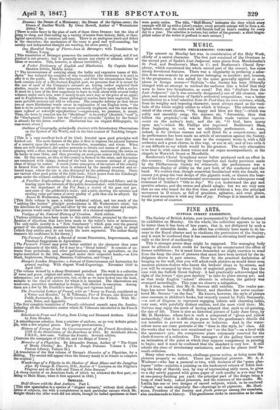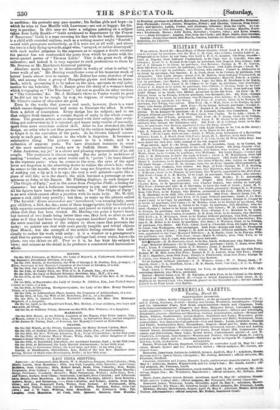FINE ARTS.
SUFFOLK STREET EXHIBITION.
The Society of British Artists, now incorporated by Royal charter, opened its exhibition on Monday. On the whole, the collection appears to us to be better than it has been of late years; that is, not disfigured by such a number of miserable daubs. An effort has evidently been made to do ho- nour to the Royal charter and to vindicate the pretensions of the Society; and it must be confessed that it has succeeded in elevating itself more gene- rally to the level of mediocrity.
This is stronger praise than might be supposed. The managing body must be allowed much credit for having so far counteracted the effect of former exhibitions; for it must have demanded no slight exertion to weed from the heap the class of pictures that must have been invited by the in- dulgence shown in past seasons. Show by the practical declaration of hanging on the wall, that you will admit such pictures as would deter even amateur picture-dealers who haunt the brokers' shops in by-streets, and you will be swamped by those fruits of neglected genius. That was the case with the Suffolk Street Gallery: it had practically acknowledged the right of the lowest " sign-post daubery " to take its place among art; and as that truly English " school " abounds in scholars, the gallery was swamped accordingly. This year we observe a mitigation.
It is true, indeed, that Mr. G. Stevens still exhibits. The reader per- haps has never been to Suffolk Street, and therefore has never encoun- tered Mr. Stevens " on the line." He knows, however, the style of picture once common in children's books, but recently routed by Felix Summerly, —a sort of diagram to represent engaging infants and charming ladies, very neat, with painfully distinct outline, and the most vivid tints: Mr. Stevens may enjoy the merit of having adapted that style to oil-painting, the size of life. There is also an historical picture of Lady Jane Grey, by Mr. H. Hawkins; whose face is such a compound of "green and yellow melancholy," that it is difficult to guess how the gentleman's friends did not interfere to prevent an exposure so ludicrous. And in the water- colour room are some portraits of the "done in this style, 5s." class. All the works that we have now mentioned are " on the line "—on a level with the spectator's eye; the conspicuous place commonly reserved for the chefs-cfceuvre of a collection. The managers of the gallery thus convey an intimation of the point at which they suppose competency in painting to begin; and it must be confessed that the standard is very low. It still admits the class of involuntary caricatures, and thus far places itself be- neath criticism.
Many other works, however, challenge graver notice, as being more like pictures properly so called. There are historical pictures. Mr. A. J. Woolmer—who has a pastoral or two, with denizens of the "poses plas- tiques " tribe—exhibits a painting on the hackneyed subject of Edith find- ing the body of Harold; and, by way of representing early morn, he gives us a sky newly papered with green paper of such quality as you may buy at one-penny-farthing per yard; the principal part of the design being a heap of dead body, naked prisoners, and the costume of the studio. Air. Latilla has one or two designs of sacred subjects, which, to be rendered " classic," are made singularly fiat—drawings in oil pigments. Mr. Hurl- atone, President of the Society and facile princeps among the members, also condescends to history. This gentleman sinks in execution as he rises
in ambition: his portraits may pass muster; his Italian girls and boys-in which he tries to fuse Murillo with Lawrence-are not so happy; his his- tory is peculiar. In this case we have a religious painting on a subject taken from LaIla Rookh-" Guilt awakened to Repentance by the Prayer of Innocence." Guilt is a man covering his face with his hands; Innocence is a child with rounded outlines, such as a writing-master might " flourish" -and with premature melancholy, as if it were not at all well; and above the two is a lady flying upwards, angel-wise, "arrayed, or rather disarrayed," with such malice prepense in the exposure as to suggest a doubt whether the painter has not confounded the poem from which he quotes with the never-quoted poems of " Thomas Little." This is the great work of the collection; and indeed it is very superior to such productions as those by Kr. Stevens or Mr. Hawkh is's historical painting.
Absolute merit begins to be discernible in works of what is called "a rower walk of art." Mr. Herring contributes some of his immense stock of homes' heads almost true to nature. Mr. Zeitter has some sketches of real life, and among them a group of Hungarian gipsies and ladies on horse- back; which, presuming it to be taken on the spot, amounts to real infor- mation for the beholder. Mr. C. Baxter gives the study of a woman's head, which is engaging as " The Wanderer"; but not so goodin its other versions as " The Circassian," &c. Mr. J. Holland's views in Venice would be good if he did not try to be rough, by way, we suppose, of seeming vigorous. Mr. Clater's scenes of character are good. Even in the works that possess real merit, however, there is a want which causes disappointment and seems to frustrate the effect. It arises from a defect of conception. Every design has its subject; and to set that subject forth demands a certain degree of unity in the whole compo- sition. The greatest artists are so impressed with their subject, that every- thing not subvervient to it is rejected; and hence unity results of necessity, apart from mere conscious critical skilL After he has sketched the first deaign, an artist who is not thus possessed by the subject imagined is liable to forget it in the execution of the parts. As he devotes himself succes- sively to each part, its relation to the whole is forgotten. It becomes a. substantive thing. The picture ceases to be a whole, and is a collection of separate parts. We have abundant instances in some of the most meritorious works now in Suffolk Street. Mr. Clater's " John Anderson, my jot " is a clever and pleasing representation of an old couple. The sentiment is almost caught. But the artist is ambitious of making " touches," or, as an actor would call it, "points "; he loses himself in the separate parts: when he comes to the eyes, the eyes of the aged lover are forgotten in the absorbing desire to realize the crow's-foot; when he comes to the mouth, the words of the song are forgotten in the ardour of making out a lip as it is in age; the coat is well painted-quite like a piece of still life; so is the shawl; the stick becomes a personage as con- apicuous as John or his Baucis. Mr. Pidding displays, in such designs as The Origin of Party," and in the scene from Peregrine Pickle, a feeling for character; but also a ludicrous incompetency to put any parts together: all his figures have been broken on the rack. In " The Origin of Party " is an arm whichcannot effect a junction with its main body. Mr. W. Gill paints a sick child very prettily; but then, to make up the picture called " The Invalid," divers accessories are " introduced,"-a weeping lady, some gay children, a bird, &c. &c.; none of them inappropriate, but handled each with separate concentration Of treatment, and joined as rudely as a cracked china dish that has been riveted. Mr. Herring can paint a horse's head; but instead of two heads being better than one, they look as alien to each other as if they had been brought from separate knackers' yards. It is not the mere material nature of the subject in these cases that prevents the unity: no painter can deal with more purely tangible and trivial objects than Moeris; but the strength of the artistic feeling elevates him suffi- ciently to endow his work with unity: it is a window or a greengrocer's stall that he paints-one thing-' every cabbage-leaf, every onion, knows its place; one sun shines on all. Poor as it is, he has kept his subject in view; and minute as the detail is, he produces a consistent and harmonious
Whole.



































 Previous page
Previous page